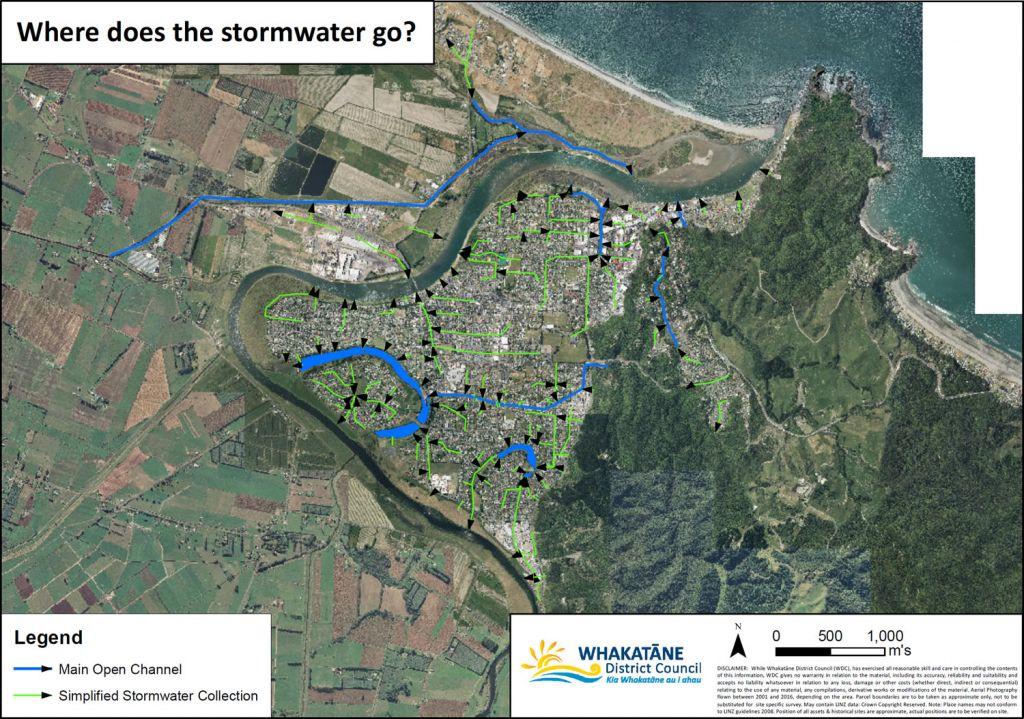We're currently reviewing the management of the Whakatāne urban stormwater systems, including the quantity and quality of stormwater run-off. This is driven in part by the need to obtain a Comprehensive Stormwater Consent (CSC) for the Whakatāne urban area. We're using this as an opportunity to plan for a stronger, more resilient stormwater system.
- What is stormwater?
- Why do we need to be concerned about stormwater?
- What is a Comprehensive Stormwater Consent?
- What will the CSC application mean for my property?
- What changes when Council obtains a CSC?
- Where does the stormwater go?
- Stormwater quality investigation
- We're all responsible for...
What is stormwater?
Stormwater is the rainfall that runs off hard surfaces such as your roof, driveway, lawn, roads, footpaths, industrial yards, and hillsides. It travels by gravity along natural flow paths and enters the stormwater network. During the growth of Whakatāne, stormwater systems have been established which use the natural environment as well as stormwater drains and / or pipes (where they exit) to carry the rainfall untreated to the nearest waterway. Conventional systems at the time generally involved piping flows away from the source to a discharge point as fast as possible.
Why do we need to be concerned about stormwater?
Stormwater is managed for two key reasons: To control the quality and quantity issues of run-off.
Stormwater in Whakatāne is currently discharged - untreated - into streams and rivers which take it out to the ocean. The run-off can collect contaminants from the land and properties it travels across which can result in the pollution of our waterways.
That’s why it’s important that stormwater is kept as clean as possible. We’re all expected to do our part to keep the stormwater network healthy to protect our environment and ourselves. This includes not washing paint brushes in the drain, not dropping rubbish or cigarette butts on the street, and managing the run-off from our properties.
Stormwater quantity issues are about the volume and timing of the run-off. In Whakatāne (because we live in a flood prone area) when we get significant rainfall events, the intensity of stormwater run-off can create local flooding issues.
What is a Comprehensive Stormwater Consent?
A Comprehensive Stormwater Consent (CSC) is an approval from the Bay of Plenty Regional Council to undertake stormwater-related activities for an entire urban catchment or a group of urban catchments for which the application was made. Before we apply for the Whakatāne CSC, it will review and consider:
- What are the current stormwater issues experienced by the Whakatāne community?
- The impacts on the environment from the discharge of stormwater; and
- What are the preferred stormwater management solutions to the issues identified.
We will then be developing a Whakatāne stormwater management plan, which includes the best options and techniques for the future management of stormwater. This plan will look ahead to 2050 to encompass the local development and the anticipated impacts of climate change. This plan, when developed, will be shared with the Whakatāne community.
What will the CSC application mean for my property?
If your property is within the Whakatāne area and discharges into the public stormwater system, then the stormwater run-off from your property will be included within the CSC.
We want to hear from you to learn about any stormwater issues you have experienced on your property and what potential solutions you have considered. We will then be able to assess how those issues could be included within this stormwater review.
Comprehensive Stormwater consent application is for all public stormwater systems within the Whakatāne catchment area and includes some of the private stormwater systems.
What changes when Council obtains a CSC?
The day-to-day management of the existing public stormwater assets will remain the same.
When the CSC is approved, the Bay of Plenty Regional Council will have greater oversight of the urban stormwater system. This will require us to undertake adequate monitoring of stormwater quantity and quality. We will have to ensure that private stormwater systems (if they discharge into the public system) comply with the requirements of the CSC.
Where does the stormwater go?
Below is a map showing the location and flow directions of the main open channels and simplified stormwater collection systems in the Whakatāne township.
Stormwater quality investigation
As part of our stormwater management review we’re investigating the quality of runoff from a number of zones within the Whakatāne township. For more information on the zones and common pollutants found in stormwater, see the information sheet below.
We're all responsible for...
- Managing and minimising the stormwater run-off from our properties
- Being vigilant in protecting our stormwater by not allowing rubbish or other pollutants to enter stormwater, which through the drains can then reach our streams, rivers and beaches.
- Ensuring our stormwater is not entering wastewater systems in order to protect our communities from overloading of our wastewater systems
- Understanding the risks of living in a flood-prone area and be more prepared for when a flood occurs. Whilst plans for future management of stormwater systems aim to minimise flooding issues, these systems are not able to prevent flooding for all events.
